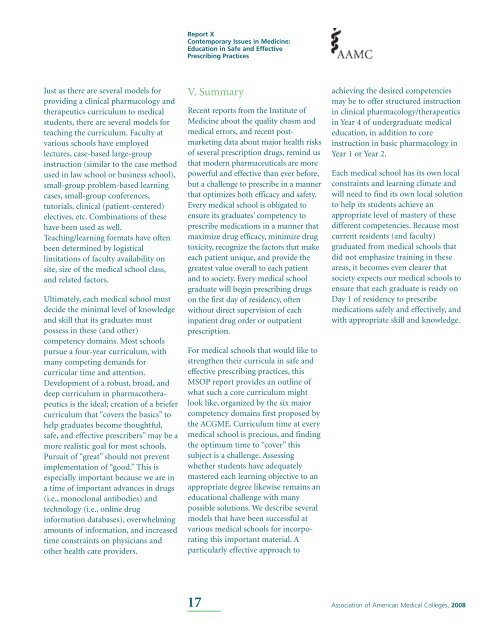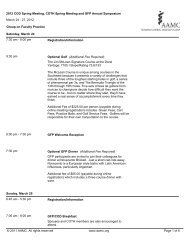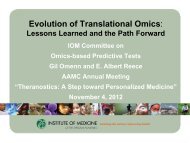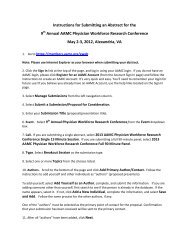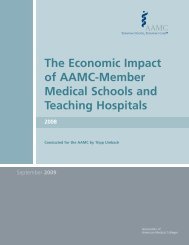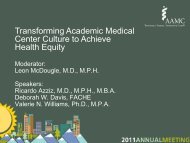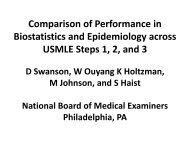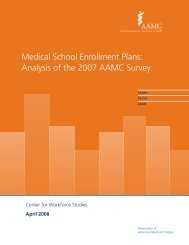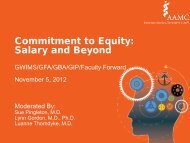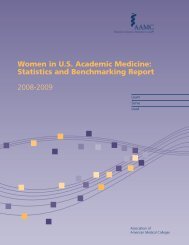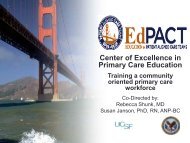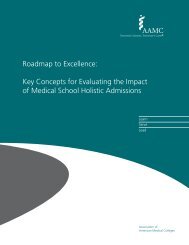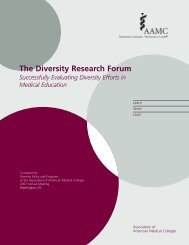Education In Safe and Effective Prescribing Practices - AAMC's ...
Education In Safe and Effective Prescribing Practices - AAMC's ...
Education In Safe and Effective Prescribing Practices - AAMC's ...
You also want an ePaper? Increase the reach of your titles
YUMPU automatically turns print PDFs into web optimized ePapers that Google loves.
Report X<br />
Contemporary Issues in Medicine:<br />
<strong>Education</strong> in <strong>Safe</strong> <strong>and</strong> <strong>Effective</strong><br />
<strong>Prescribing</strong> <strong>Practices</strong><br />
Just as there are several models for<br />
providing a clinical pharmacology <strong>and</strong><br />
therapeutics curriculum to medical<br />
students, there are several models for<br />
teaching the curriculum. Faculty at<br />
various schools have employed<br />
lectures, case-based large-group<br />
instruction (similar to the case method<br />
used in law school or business school),<br />
small-group problem-based learning<br />
cases, small-group conferences,<br />
tutorials, clinical (patient-centered)<br />
electives, etc. Combinations of these<br />
have been used as well.<br />
Teaching/learning formats have often<br />
been determined by logistical<br />
limitations of faculty availability on<br />
site, size of the medical school class,<br />
<strong>and</strong> related factors.<br />
Ultimately, each medical school must<br />
decide the minimal level of knowledge<br />
<strong>and</strong> skill that its graduates must<br />
possess in these (<strong>and</strong> other)<br />
competency domains. Most schools<br />
pursue a four-year curriculum, with<br />
many competing dem<strong>and</strong>s for<br />
curricular time <strong>and</strong> attention.<br />
Development of a robust, broad, <strong>and</strong><br />
deep curriculum in pharmacotherapeutics<br />
is the ideal; creation of a briefer<br />
curriculum that “covers the basics” to<br />
help graduates become thoughtful,<br />
safe, <strong>and</strong> effective prescribers” may be a<br />
more realistic goal for most schools.<br />
Pursuit of “great” should not prevent<br />
implementation of “good.” This is<br />
especially important because we are in<br />
a time of important advances in drugs<br />
(i.e., monoclonal antibodies) <strong>and</strong><br />
technology (i.e., online drug<br />
information databases), overwhelming<br />
amounts of information, <strong>and</strong> increased<br />
time constraints on physicians <strong>and</strong><br />
other health care providers.<br />
V. Summary<br />
Recent reports from the <strong>In</strong>stitute of<br />
Medicine about the quality chasm <strong>and</strong><br />
medical errors, <strong>and</strong> recent postmarketing<br />
data about major health risks<br />
of several prescription drugs, remind us<br />
that modern pharmaceuticals are more<br />
powerful <strong>and</strong> effective than ever before,<br />
but a challenge to prescribe in a manner<br />
that optimizes both efficacy <strong>and</strong> safety.<br />
Every medical school is obligated to<br />
ensure its graduates’ competency to<br />
prescribe medications in a manner that<br />
maximize drug efficacy, minimize drug<br />
toxicity, recognize the factors that make<br />
each patient unique, <strong>and</strong> provide the<br />
greatest value overall to each patient<br />
<strong>and</strong> to society. Every medical school<br />
graduate will begin prescribing drugs<br />
on the first day of residency, often<br />
without direct supervision of each<br />
inpatient drug order or outpatient<br />
prescription.<br />
For medical schools that would like to<br />
strengthen their curricula in safe <strong>and</strong><br />
effective prescribing practices, this<br />
MSOP report provides an outline of<br />
what such a core curriculum might<br />
look like, organized by the six major<br />
competency domains first proposed by<br />
the ACGME. Curriculum time at every<br />
medical school is precious, <strong>and</strong> finding<br />
the optimum time to “cover” this<br />
subject is a challenge. Assessing<br />
whether students have adequately<br />
mastered each learning objective to an<br />
appropriate degree likewise remains an<br />
educational challenge with many<br />
possible solutions. We describe several<br />
models that have been successful at<br />
various medical schools for incorporating<br />
this important material. A<br />
particularly effective approach to<br />
achieving the desired competencies<br />
may be to offer structured instruction<br />
in clinical pharmacology/therapeutics<br />
in Year 4 of undergraduate medical<br />
education, in addition to core<br />
instruction in basic pharmacology in<br />
Year 1 or Year 2.<br />
Each medical school has its own local<br />
constraints <strong>and</strong> learning climate <strong>and</strong><br />
will need to find its own local solution<br />
to help its students achieve an<br />
appropriate level of mastery of these<br />
different competencies. Because most<br />
current residents (<strong>and</strong> faculty)<br />
graduated from medical schools that<br />
did not emphasize training in these<br />
areas, it becomes even clearer that<br />
society expects our medical schools to<br />
ensure that each graduate is ready on<br />
Day 1 of residency to prescribe<br />
medications safely <strong>and</strong> effectively, <strong>and</strong><br />
with appropriate skill <strong>and</strong> knowledge.<br />
17<br />
Association of American Medical Colleges, 2008


